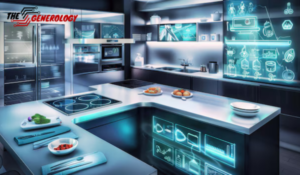AI in Kitchen Design: Transforming Spaces with Technology
The kitchen is traditionally the central point of every house, the place for preparing food, and the meeting point. Over the last few years, technological advances have brought artificial intelligence (AI) along with it, a tool that is changing how kitchens are designed. In the sixteen ways discussed here, artificial intelligence is transforming the efficiency of the design process, creativity, sustainability, and the ability to deliver solutions considering space users, including the kitchens that populate them. In this article, the author delves into how AI is revolutionizing the approach to kitchen design and how homeowners can get the best of this technology.
1 The Role of AI in Kitchen Design
The Introduction of AI in Interior Design
AI integration into the interior design industry has raised home renovation projects to a new level of complexity. No longer does a homeowner have to rely solely on specialists to design a kitchen; with the help of artificial intelligence, it is possible to design the kitchen simultaneously, allowing the homeowner to have more control over the said process. In design computation, layouts are created using analysis tools derived from data analysis, machine learning, and simulation tools that provide initial design and real-time feedback on design elements.
Benefits of AI in Kitchen Design
- Customization: Design a kitchen layout according to the user’s likes, habits, and house requirements.
- Time Efficiency: Shortens the design procedure since it is easier to model modifications and receive quick feedback.
- Cost Savings: Reduces costs by providing accurate budget estimates and work cost analysis, thus avoiding costly mistakes.
- Sustainability: Promotes environmental conservation by offering environmentally friendly materials and power-saving measures.
2 Personalized Kitchen Design with AI
How AI Creates Customized Design Plans
AI pointing design software involves inputting design parameters using data set algorithms to produce customized kitchen layouts for a user. Based on the user requirements, habits, and general space, these systems may develop design solutions that perfectly blend with the homeowner’s image. Here’s how AI achieves this level of personalization:
- User Profiles: Consumers feed context regarding cooking and storage requirements, family sizes, and so on, fed into AI to generate recipes for layout configuration.
- Smart Algorithms: Machine learning algorithms stay in touch with the users and make better suggestions as they acquire more data.
- Visualization Tools: It is also possible for users to view their kitchen design from every angle and viewpoint with the help of the developed three-dimensional modeling.
Key Features of AI-Powered Design Tools
- Drag-and-Drop Functionality: This enables the user to swap the layouts easily to compare the differences.
- Real-Time Adjustments: Everything is changeable on the fly, and you can instantly see the results of the change.
- Style Matching: AI can recommend additional colors, materials, and patterns to fit the overall design solution properly.
3 AI in Space Planning and Optimization
Efficient Use of Space with Artificial intelligence
The biggest problem that kitchen designers need help with is the issue of space, especially in the context of a small house. Using Artificial intelligence, there is an opportunity to input data specifying the dimensions of a room and get an optimal layout for every square meter. This comes in handy in compact kitchens or when one wants to replace their old kitchen in a confined space.
AI-powered space optimization offers:
- Traffic Flow Analysis: AI ensures that frequently used appliances such as sinks, stoves, and refrigerators are well placed to form a triangle to reduce circulation within the house.
- Customized Storage Solutions: AI provides possibilities for cabinet placing, including pull-out cabinets, corner furniture sets, and many others that will allow you to organize the space optimally without limiting container access.
- Flexible Design Options: The users can also adjust all the elements and modules of the site and determine which layout is best for use.
Benefits of Artificial intelligence in Space Planning
- Improved Accessibility: Make sure that possible kitchen accommodations are arranged so as not to cause any strain and effort when used.
- Optimized Workflow: Group of appliances and spaces needed to perform the work, such as cooking and washing.
- Adaptability: Proposed changes in space planning can be seen immediately; thus, the following solutions that could have been cumbersome to try out earlier are presented.
4 Integrating Smart Technology in Kitchen Design
The Rise of Smart Kitchens
Artificial intelligence isn’t limited to creating impressive designs but also focuses on how the design works. Smart appliances and IoT (Internet of Things) in the kitchen have emerged as the newest trend in kitchen design to manage homes. Intelligent refrigerators have technology that can help food companies monitor inventory, while sensors and interfaces ‘teach’ ovens about people’s cooking habits.
Examples of AI-powered smart Kitchen Features
- Smart Refrigerators: Under-controlled cameras and sensors help check the contents and send notifications once the products are depleted or near expiration.
- Voice-Controlled Assistants: Smart home devices such as Amazon Alexa and Google Assistant can turn on the lights, set the time, and even help find recipes while cooking.
- Automated Cooking Appliances: Smart ovens can be turned on at a given time, the temperature can be regulated, and recipes can be made as per step.
Benefits of Smart Kitchen can be added.
- Increased Efficiency: Smart devices can do almost anything, and online help can be hired to perform as many chores as one wants them to do, including cooking.
- Convenience: Remote operation is another benefit, meaning users can operate the machine when they are not at home.
- Energy Savings: Smart appliances help eradicate a bulk of energy wastage in the household, leading to more efficient energy use.
5 Sustainable Design with AI
Eco-Friendly Kitchen Solutions
Today, you hear of going green, where sustainable kitchen design takes its cue from. In line with this trend, artificial intelligence plays a role by recommending experimental materials and solutions that would correspond to environmentalism. This ranges from choosing a type of wood obtained in an environmentally friendly way to suggesting energy-efficient appliances for optimum home use.
How Artificial intelligence Helps with Sustainability
- Energy Monitoring: Products of artificial intelligence in kitchens include energy consumption alerts that help find ways to minimize the energy used in the kitchen, such as using appliances during low demand.
- Material Recommendations: artificial intelligence can then advise homeowners to use recycled or sustainable materials in the countertops, the cabinet, and the floor.
- Water Conservation: Bracketed by sensors, smart faucets can assist in minimizing water wastage, which means that they aid in water conservation.
Advantages of a Sustainable Kitchen Design
- Lower Utility Costs: Energy-saving appliances and energy-efficient layouts result in low energy costs.
- Reduced Carbon Footprint: Sustainability helps to make the planet a better place to live in.
- Long-Term Savings: In this case, sustainable solutions and products will likely be characterized by a prolonged service life and a lesser need for replacements.
6 Time and Cost Efficiency with Artificial intelligence
Reducing Design Time and Expenses
This paper now turns to the following major benefits of integrating artificial intelligence in kitchen design: One of the biggest advantages is that it can help save time and money. The conventional K. design procedures may necessitate several appraisals, planning encounters, and tangible models. artificial intelligence solves these shortcomings by presenting a virtual design environment where users can see designs, make adjustments, and approve them without scheduling numerous physical meetings.
AI tools streamline costs through:
- Accurate Budgeting: Artificial intelligence platforms offer budget operations forecasts and help homeowners avoid overspending their budgets.
- Reduced Waste: The planning system deployed by artificial intelligence ensures that only the correct number of materials are ordered, reducing wastage.
- Fewer Revisions: With real-time, artificial intelligence has the potential to show expected modifications better, eliminating the need for multiple rounds of planning.
The Role of Real-Time Feedback
One major advantage of using artificial intelligence systems is that they simultaneously give feedback on the effect of design changes. It is most useful for deciding where to put appliances or move walls to change layouts and how to decorate a particular section or space.
7 Real-Time Visualization and Augmented Reality (AR)
Immersive Visualization Tools
Modern design technologies rely on artificial intelligence and apply augmented reality to allow the homeowner to see what the room will look like after constructing a new kitchen. Therefore, This technology allows the audience to relocate through proposed kitchen designs as if the structures were accomplished.
Advantages of AR in Kitchen Design
- Improved Decision-Making: Real visualization enables homeowners to make informed decisions on space planning, choice of materials, painting, and decoration.
- Instant Feedback: Instead of making changes to the design on paper, as in the case of Pictionary, the changes can be made to the AR space instantly, eliminating the need for changes.
- Enhanced Customization: In the AR environment, users can decide the type of handle on the cabinet, the kind of countertop, the type of light, etc.
FAQs About Artificial intelligence in Kitchen Design
1 How does Artificial intelligence create personalized kitchen designs?
AI considers factors from cooks, their preferences, and available home space to develop unique designs that suit the homeowners’ needs.
2 What is the main benefit of using Artificial intelligence in kitchen design?
The biggest advantage is that more concepts can be personalized and optimized faster regarding space utilization, workflow, and expense.
3 Can Artificial intelligence help with choosing sustainable materials?
Of course, artificial intelligence can suggest more environmentally safe materials depending on the user’s choice and ecological targets.
4 How does Artificial intelligence improve space optimization?
Two, artificial intelligence also employs near-act and real-time contingency experiments to compare the arrangement of stock AGVs within the kitchen area to improve the design layout of its components.
5 What are smart appliances, and how do they work?
Smart appliances are defined as devices that are connected to other devices and can be accessed remotely by applications and voice commands. They can detect usage, train themselves in user practices, and assist in controlling kitchen operations.
6 Can Artificial intelligence design a kitchen for a very small space?
Yes, it was seen that due to its versatility and flexibility, the role of artificial intelligence is especially beneficial for designing small kitchens because the AI tool can fit the most necessary appliances and utensils while suggesting optimal ways of positioning them.
7 How much does it cost to use AI-powered kitchen design tools?
The cost of building a basic website is more affordable than that of creating a more complex site with multiple design elements. While some tools are open-source or restricted to a trial version, others are paid with a monthly or a one-time user fee.
8 Are there any limitations to using Artificial intelligence in kitchen design?
From this, it is apparent that the application of artificial intelligence tools requires quality input data and may only partially disembody the human designer, especially for a complex or creative design job.
9 What are the most popular Artificial intelligence kitchen design tools?
Examples are SketchUp home design software, Home Designer suite, and home improvement companies’ artificial intelligence solutions.
10 Can Artificial intelligence help with designing kitchens for accessibility?
Definitely, yes, through our analysis and giving recommendations on the layout of the different designs involved in the kitchen, we can make sure it’s disability-friendly by suggesting that counters be a bit lower or that the appliances be placed in easily accessible areas by disabled persons.
Conclusion
AI is in the process of transforming the ways that help to design the kitchen better, more effective, more individualistic, and more ecological. Whether you anticipate a new kitchen or refurbishing an existing one, integrating AL could be valuable in designing a functional area that will otherwise reflect the client’s personality. Soon, artificial intelligence and smart design tools will only become more intertwined, so how people conceptualize and realize their kitchens will still expand.
Read more:>
